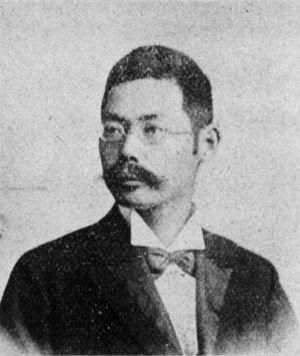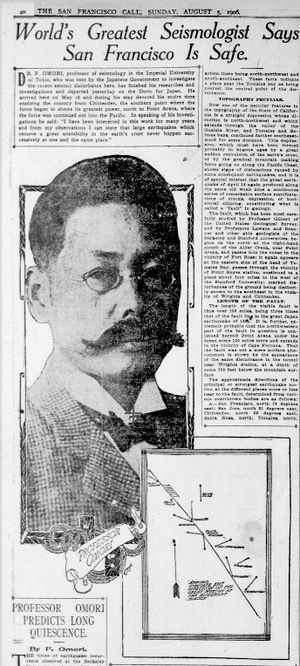Fusakichi Omori facts for kids
Fusakichi Omori (born October 30, 1868 – died November 8, 1923) was a very important Japanese scientist. He was a pioneer in seismology, which is the study of earthquakes. He was the second head of seismology at the Imperial University of Tokyo. Omori is famous for his work on aftershocks, which are smaller earthquakes that happen after a big one. He created a rule, now called Omori's Law, that explains how often aftershocks occur.
Contents
Early Life and Learning
Omori studied physics at the Imperial University of Tokyo. He learned from British teachers, like John Milne, and Japanese experts, such as Seikei Sekiya. Sekiya became the first professor of seismology at the university in 1880.
Sekiya and Omori were the first to record a strong earthquake clearly. They used special measuring tools at the university. In 1886, Sekiya became the head of seismology. By the time he passed away, Japan had almost 1,000 stations to record earthquakes.
In 1891, Omori became Sekiya's assistant. In 1893, he started teaching seismology at the Imperial University. He traveled to Germany and Italy in 1895 to study more. He also visited England briefly in 1896.
After Sekiya's death in 1896, Omori took over as the head of seismology. He could read and write in English, German, Italian, and Japanese. He often wrote scientific papers in all these languages.
Omori's Seismometer
In 1899, Omori created a new type of horizontal pendulum. This device was later named the Omori seismometer. With some changes by the J&A Bosch Company, it became known as the "Bosch-Omori Seismometer."
These Bosch-Omori seismographs were used all over the world. They were a main part of the global network for recording earthquakes until after World War II.
Studying Earthquakes Around the World
On October 28, 1891, the Mino and Owari areas in Japan were hit by a huge earthquake. Another professor, Bunjiro Koto, studied the fault lines of this earthquake. He found that the fault cut the ground for at least 40 miles. One side of the fault had moved one to two meters compared to the other.
This earthquake gave scientists important information. When they looked at data from other earthquakes, they noticed a pattern. The number of aftershocks decreases over time after a main earthquake. This pattern is what we now call "Omori's Law."
Omori also studied the three main parts of earthquake motion: the first small shakes, the main strong shaking, and the final weaker tremors. He often visited places after big earthquakes to check his data. For example, he went to Japanese Formosa (Taiwan) after the Meishan earthquake in 1906. He saw how the ground turned to liquid (called soil liquefaction) and how the town of Meishan was completely destroyed. He believed many people died because their houses were made of weak mud bricks with heavy roofs.
Omori also studied how earthquakes affect buildings. He was one of the first to use shaking tables to test how structures react to ground movement. He compared these tests with what happened during real earthquakes. This work was very important for earthquake engineering.
After the 1908 Messina earthquake in Italy, Omori noted that about 75,000 people died. He said that 99% of them died because their homes were not built to survive earthquakes.
The 1906 San Francisco Earthquake
The 1906 San Francisco earthquake was recorded by seismographs all over the world, including Omori's own designs. Many seismologists traveled to northern California after the disaster.
Omori left Tokyo on May 1, 1906, and arrived in San Francisco on May 18. He led a Japanese team of architects and engineers. Their goal was to study the damage from the earthquake. They also brought a new seismograph as a gift for the University of California.
Omori and his team spent about 80 days in California. They measured damaged buildings and took many photographs. Omori traveled north to Humboldt County, California and south along the San Andreas Fault. He observed how the ground, buildings, and even large redwood trees reacted to the earthquake. He noted that some redwood trees were split by the ground's strong sideways motion.
Omori studied the earthquake's effects by looking at tombstones and cracks in building walls. He created the first scale to describe earthquake damage. This scale used both instrument readings and what people saw. Omori's seismographs were quickly set up across northern California. A list of aftershocks from the San Francisco earthquake was also put together and published. Omori returned to Japan on August 4, 1906.
Studying Volcanoes
From his early work on the Mount Azuma eruption in 1893 until his death, Omori also studied Japanese volcanoes. He identified different types of volcanic earthquakes. He gathered data from eruptions of Mount Asama, the 1910 Mount Usu eruption, and the 1914 Sakurajima eruption. His warnings before the Usu and Sakurajima eruptions helped save many lives.
Omori also helped design the foundations for the Whitney Laboratory of Seismology in Hawaii. This lab is now part of the Hawaiian Volcano Observatory. In 1912, Omori sent two of his instruments to Hawaii for this observatory.
Final Years
In the fall of 1923, Omori attended a science meeting in Australia. There, he and another scientist, Edward Pigot, saw a seismograph recording the huge 1923 Great Kantō earthquake. This earthquake destroyed Yokohama and Tokyo on September 1, 1923. About 140,000 people died, and 1.9 million lost their homes.
Omori returned to Japan on October 4, 1923. Soon after, he was diagnosed with a brain tumor. He passed away on November 8, 1923, at the age of 55. A few days before he died, he received the Order of the Sacred Treasure from the Imperial Court of Japan, a very high honor.
See also
 In Spanish: Fusakichi Omori para niños
In Spanish: Fusakichi Omori para niños



